There’s nothing quite as relaxing as coming home from a hard day at work and going for a swim or a soak in your own pool. New Yorkers know a thing or two about hustle and bustle, but they also know how to play. Owning your own fiberglass or vinyl liner pool can invite more of a sense of play into your life, giving you a place to get away from the daily grind and make memories with loved ones.
While “The Big Apple” is synonymous with bright lights, culture and the best of many worlds, there’s even more to New York beyond just New York City. From sports-loving Buffalo to beautiful Ithaca with its nature trails and close proximity to the Finger Lakes – all the way to its lively capital in Albany, New York state has so much to offer.
No matter where you live in “The Empire State,” a pool is the perfect complement to your lifestyle. Maybe you’re an avid outdoors enthusiast who wants to spend time outside, but also relax sore muscles from constant activity. Or perhaps you dream of firing up the grill for friends and family poolside, watching a Mets or Yankees game (we won’t judge either way) with a drink in hand and toes in the water.
New York has hot, humid summers, chilly winters and brisk autumn weather. To help beat the heat and give you the best seat in the house to enjoy the state’s gorgeous views, owning a pool can be a worthwhile investment – and adding heating elements or a spillover spa can help you squeeze in even more pool time year-round!
Keep in mind that, according to Jon Foshee, “The best pool is built using the best materials. Don’t settle for less!” With Latham, you have a variety of quality materials at your fingertips. “Choose from Polymer Wall, Vinyl Lined, or Fiberglass. Both options are 100% non-corrosive and built to last.”
Fiberglass and vinyl liner pools are incredibly popular with New Yorkers, offering versatility and ease of maintenance. If you’re considering a new pool, we’ll share a glimpse of gorgeous designs to inspire you, tips for maintaining your pool, and rules and regulations for owning a swimming pool in New York. Let’s dive in!
New York Fiberglass Pools
In recent years, fiberglass pools have become an overwhelming favorite among New Yorkers for a number of reasons. Sure, they’re easy on the eyes with a gloriously smooth, crystalline finish, but they’re also easy to maintain and install. Fiberglass pool shells are pre-manufactured offsite, meaning once a professional excavates a space in your backyard, they can be swiftly installed without having to worry about a lengthy period of time to cure or settle. Faster installation means more time you get to spend in your beautiful new pool!
Fiberglass Pool Designs for Your New York Home
When it comes to fiberglass pool shapes and sizes for New York residents, you’ll find yourself pleasantly spoiled for choice. Whether you have a smaller New York backyard or a sprawling patch of greenery that’s just begging to be transformed into an outdoor oasis, there’s a pool for every personality. Here are several fiberglass pool shapes and models that we love for NY pools:
- Rectangular – If classic, clean lines speak to your style aesthetic, a rectangular-shaped pool may be right for you. Choose from models in an array of lengths and depths, capable of working with your backyard.
- Enchantment 9.17 – Feel the magic of stepping into a beautiful pool with so much to love. The Enchantment 9.17 has a built-in tanning ledge and easy-access, slip-resistant steps, making it the ideal pool for the whole family to use – from small children who may want a wading area, to adults with mobility issues.
- Delray – Simple and stylish, the Delray incorporates corner steps, maximizing the space to swim and splash. Latham’s patented approach to fiberglass laminate construction makes it 32% stronger than other manufacturers’ pools on the market. Beyond gorgeous color and durability, the Delray is also auto-cover-ready, providing you with a ton of added energy-saving benefits on top of giving you more peace of mind where safety is concerned.
- Monaco – The Monaco is a classic and classy rectangular pool made with elegance and simplicity in mind. It offers a wide top step that can double as a tanning ledge, as well as swim-up seating to accommodate guests.
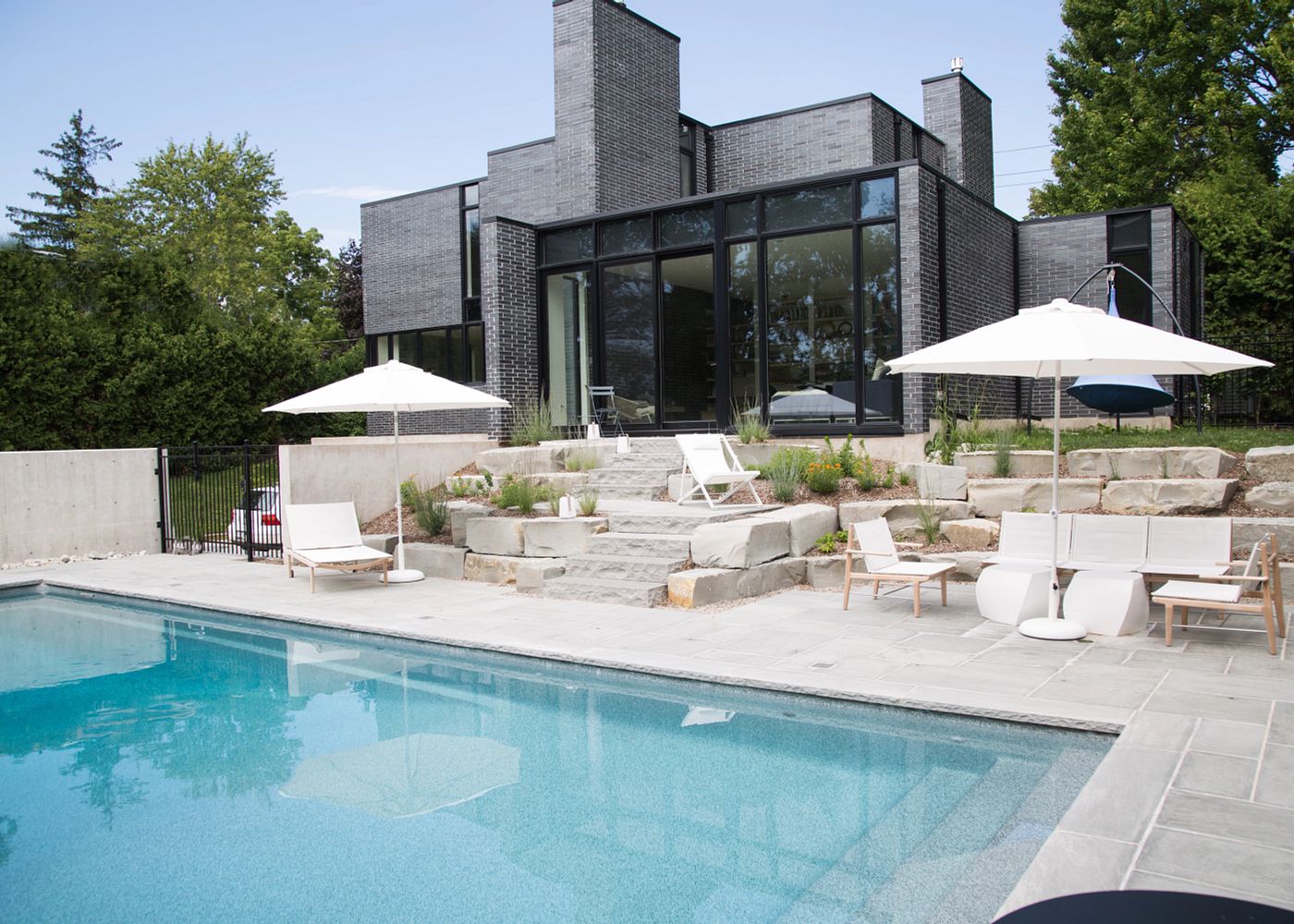
- Freeform – When you want to stay ahead of the curve, freeform pools are the way to go. They offer flexibility in terms of shape and size, giving you options regardless of how large or small your backyard is.
- Fiji – This grand modern freeform pool offers plenty of space to splash and entertain. Admire its winding curves poolside or enjoy swim-up seating from the inside of the pool, giving you and your guests a place to chat and rest your beverages.
- Axiom 12 Deluxe – For a luxurious modern freeform pool that offers something for everyone, the Axiom 12 Deluxe tops the list. A built-in spillover spa is a soothing stress-melter that you can enjoy year-round, while its wading area is ideal for youngsters to splash and play. Swim-up seating, slip-resistant steps and multiple entry/exit points round out even more to love about the Axiom 12 Deluxe!
- Vista Isle – A traditional freeform pool, the Vista Isle beckons you with its large underwater ledge, giving you a wading area that’s suitable for younger swimmers, as well as a place for everyone to soak up some sun.
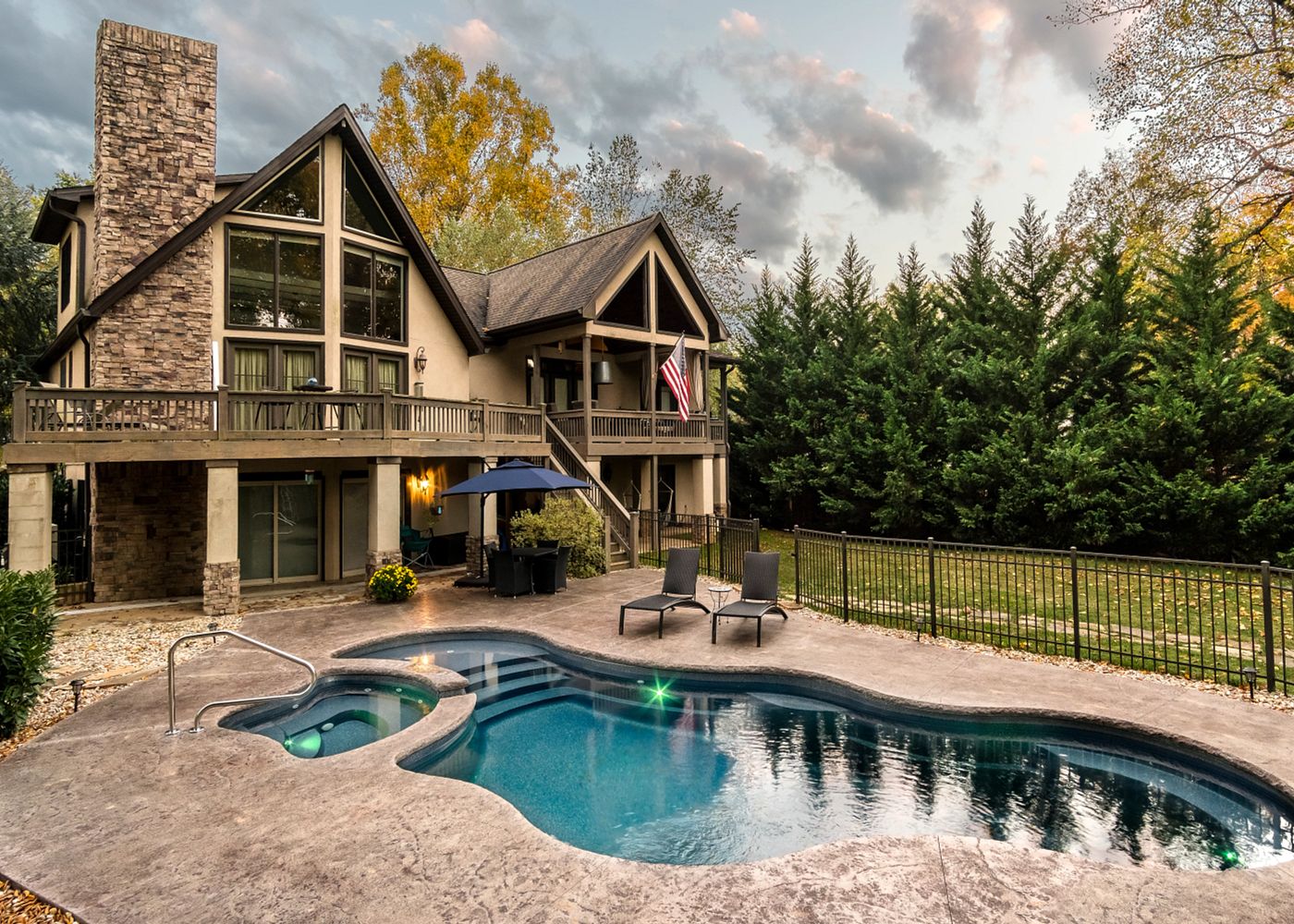
- Plunge – A plunge pool is an ideal fit for smaller yards craving all the fun of a pool in a more compact size. They’re equally at home when used for exercise or entertaining, plus offer more depth compared to other compact pool types, like dipping pools or cocktail pools.
- Milan: Clocking in at a slim and trim 10’ x 16’ size, the Milan allows smaller yards to take the plunge on enjoying a pool without skimping on features. Breathtaking Crystite color technology makes the Milan the crown jewel of your backyard from a visual perspective, while slip-resistant steps and swim-up seating make it the place to be!
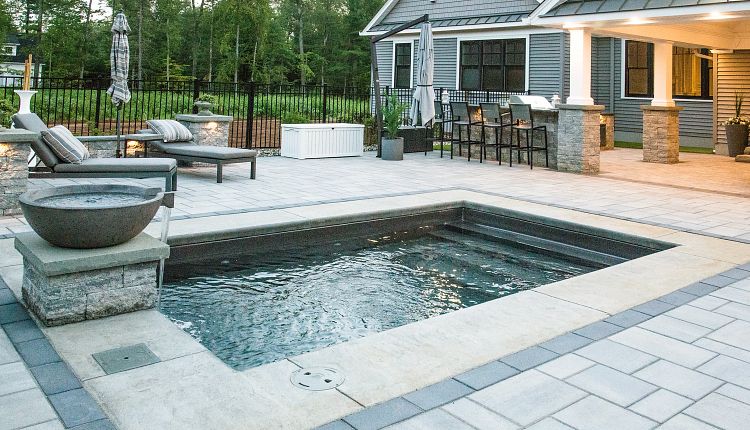
- Kidney – Kidney-shaped pools are a great fit for small or irregularly-shaped yards and are ideal for folks who are torn between classic and free-form styling.
- Jamaica – The Jamaica packs a lot of punch in a compact size. Swim-up seating and beverage benches give this pool its tropical destination feel.
- St. Lucia – With its tiered wedding cake steps and ability to be customized with a range of features, the St. Lucia is easy on the eyes and spacious enough to make it a hub of activity in your backyard.
- Valencia – The Valencia is both fun and functional – the perfect size for swimming laps or entertaining guests thanks to ample swim-up seating. Its attractive wedding cake-style steps are slip-resistant, making it beautifully accessible for pool lovers of all ages!
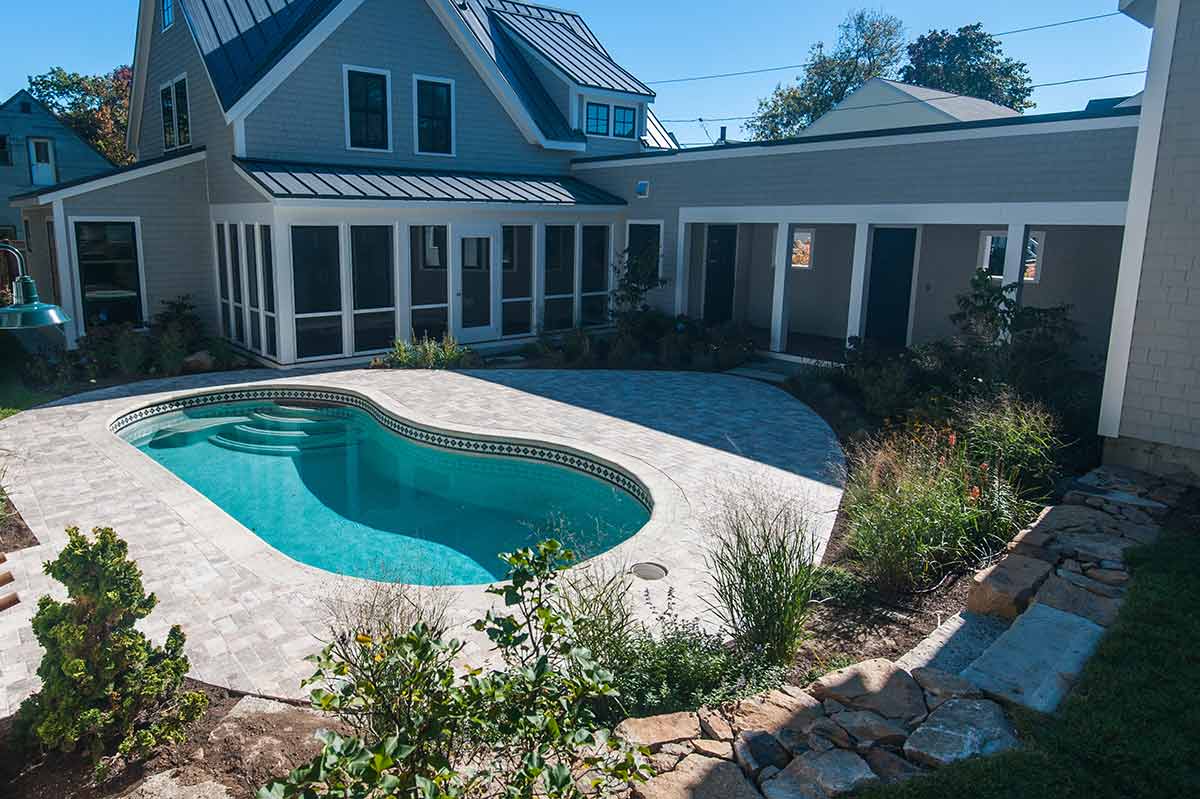
Automatic & Winter Pool Covers
Automatic pool cover can make life easier for pool owners and offer them greater peace of mind. Not only can they help protect your investment, but automatic pool covers can also help protect your family from accidents when your pool is unsupervised.
- Improved safety. First and foremost, an automatic pool cover serves as a safety barrier to prevent pets and kids from accidentally falling in. It’s your first line of defense when you can’t be there to monitor your pool at all times. An automatic pool cover can also help safeguard you from liability in the event of unauthorized use of your pool. Moreover, in New York state, if an outside wall of your home is used as part of your pool’s barrier or fencing, it’s the law that your pool be equipped with a compliant automatic safety cover or has a pool alarm.
- Reduced maintenance. An automatic pool cover can help you spend more time in your pool instead of maintaining it! An auto cover can help keep leaves, insects, debris and even food from falling into your water, potentially clogging filters or altering your water chemistry. An automatic pool cover can help you skim time off of the time you spend skimming your pool.
- Save on energy costs. Based on statistics from the U.S. Department of Energy, an automatic pool cover can help you save between 50% and 70% on your energy costs. Not only can a pool cover reduce water evaporation, but it can help you better control your water temperature. This translates to having to refill your pool less and conserving more natural resources.
When building your pool package and considering covers, be sure you ask your builder for both an autocover and a winter cover. Automatic pool covers offer a wealth of benefits, but aren’t made to support heavy snow accumulation. When chilly New York winters hit and pile on the snowfall, a winter pool cover can help protect your investment in both your pool and its autocover, ensuring a smooth glide into spring and summer when it’s time to reopen your pool.
How much does an inground pool cost in New York?
The cost to install an inground pool in New York can vary based on a number of factors. The size of your pool, materials and add-ons you may want to include (such as an automatic pool cover) are one part of the equation. The size and geographic characteristics of your yard – such as soil drainage and whether your yard sits on a slope – can also play a role in the total cost to install your pool.
To better understand your options and get an accurate estimate for a pool package that will bring you decades of enjoyment, speak with a builder. Working with an experienced pool builder can help you customize the pool of your dreams, while still working with a set budget.
Transforming or Replacing Your Current Pool
If you have an older pool that doesn’t work with your aesthetic vision or you’re not getting as much enjoyment from it as you’d like, don’t despair! It’s possible to upgrade an older pool with a new fiberglass pool shell and give it a new lease on life.
Many older pools in New York were made from concrete (sometimes called “gunite”). A concrete pool can be a pain to maintain, as their porous surface makes them more prone to pool algae, which can not only put you on the struggle bus when balancing your water chemistry, but also create unsightly stains. Additionally, the older your concrete pool gets, the rougher and chalkier its surface can get, making it look flaky and unattractive – not to mention, it’s not exactly a treat for your feet when wading in.
Fiberglass pools are an ideal solution for replacing or transforming an older pool from an ugly duckling into a graceful swan. Not only is fiberglass easier and less-expensive (both monetarily and in terms of time commitment) to maintain, but a well-maintained fiberglass pool can last for decades.
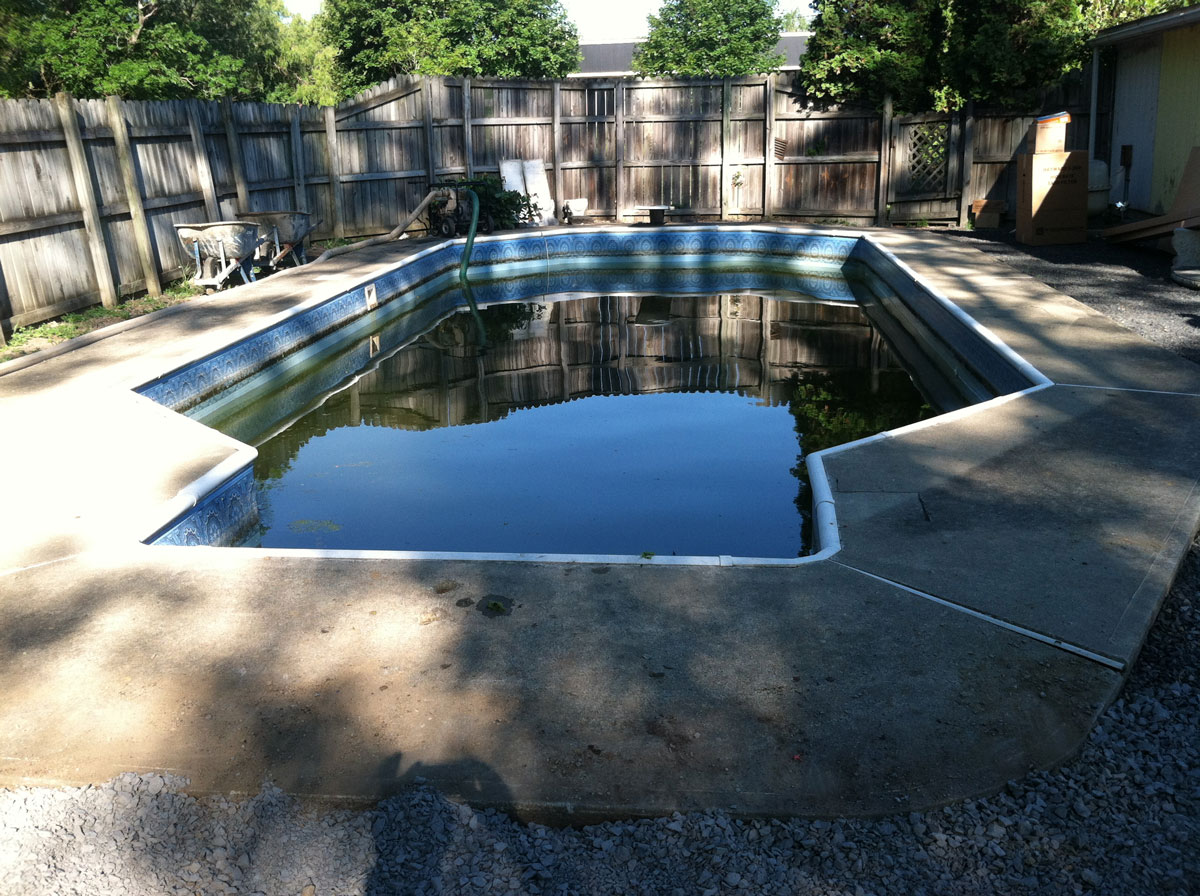
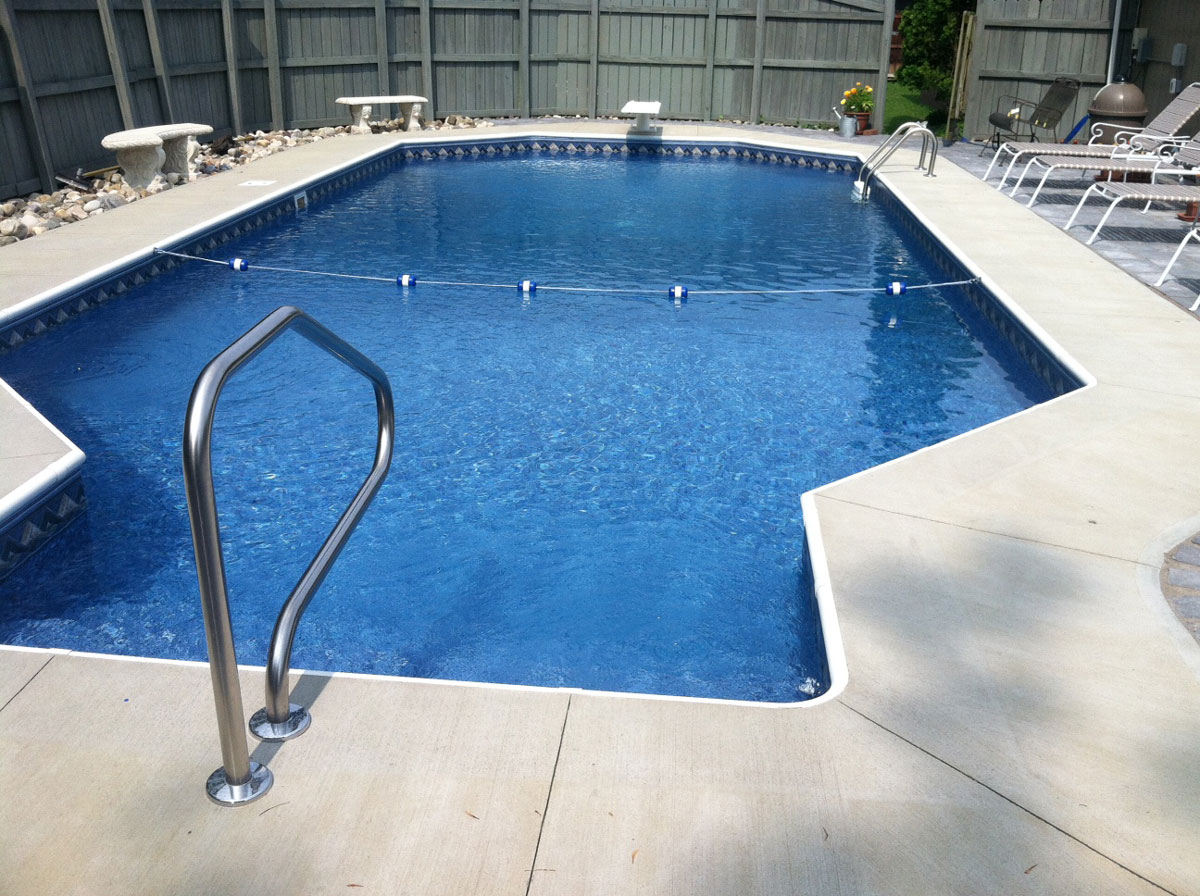
New York Pool Code for Residential Pools
Pool ownership comes with a responsibility to not just maintain it, but to be sure your pool complies with all state and local codes and regulations.
Whether you’re installing a new pool or remodeling an existing pool, there are a number of New York City and New York state private swimming pool regulations to keep in mind. Here are some of the most common questions we hear around NY pool codes. As always, it’s important to do your own research to confirm whether any regulations have changed to ensure your pool is up-to-code. Working with a licensed, reputable pool builder can also help you stay on top of any of the latest adjustments to state and local guidelines.
- What is the New York code for fences around pools?
In New York state, residential pools (as well as spas and hot tubs) must be surrounded by a permanent fence. Moreover, while a pool is under construction and there is not an existing permanent barrier the state insists that the construction site be surrounded by a temporary barrier that meets specific regulations.According to the Residential Code of New York State, “the top of the temporary barrier shall be at least 48 inches (1219 mm) above grade measured on the side of the barrier which faces away from the swimming pool.” A permanent barrier should be installed before either 90 days after the date a permit was issued or 90 days after the actual start of installation or construction of a swimming pool. In some instances, homeowners may get an extension for “good cause, including, but not limited to, adverse weather conditions delaying constructionNew York State mandates that any outdoor swimming pool (“including an in-ground, above-ground or on-ground pool, hot tub or spa”) must be surrounded by a barrier at least 4 feet high (12199 above grade) “measured on the side of the barrier that faces away from the swimming pool.The maximum vertical clearance between grade and the bottom of the barrier shall be 2 inches (51 mm) measured on the side of the barrier which faces away from the swimming pool…. Openings in the barrier shall not allow passage of a 4-inch-diameter (102 mm) sphere.”New York state also has some strict guidelines around what’s required of a pool fence, depending on the type of material you use. Solid barriers without openings (such as brick or stone walls “shall not contain indentations or protrusions except for normal construction tolerances and tooled masonry joints.” If you use fencing that makes use of vertical slats, NY state requires that “the distance between the tops of the horizontal members is less than 45 inches (1143 mm), the horizontal members shall be located on the swimming pool side of the fence. Spacing between vertical members shall not exceed 13/4 inches (44 mm) in width.” Additionally, there are requirements around any decorative cutouts in this type of fencing.If you have a chain link fence surrounding your pool, New York state requires that the ‘maximum mesh size for chain link fences shall be a 21/4-inch (57 mm) square unless the fence has slats fastened at the top or the bottom which reduce the openings to not more than 13/4 inches (44 mm).” Similarly, for lattice-style fencing, “the maximum opening formed by the diagonal members shall not be more than 13/4 inches (44 mm).”To be sure any fencing surrounding your pool is compliant with the most recent state regulations, inquire with your local building office to confirm. Working with a licensed pool builder can help you better understand your responsibilities and be sure your pool and any accessories on or around it are up-to-code. - What is the New York state code for pool gates?
The residential code of New York state requires that all pools have self-closing gates. Taking it a step further, if a pool gate is also a pedestrian access gate, it must open outward, away from the pool.Similarly, the state has strict requirements around gate closures, requiring that “all gates shall be self-latching, with the latch handle located within the enclosure (i.e, on the pool side of the enclosure) and at least 40 inches (1016 mm) above grade. In addition, if the latch handle is located less than 54 inches (1372 mm) from the bottom of the gate, the latch handle shall be located at least 3 inches (76 mm) below the top of the gate, and neither the gate nor the barrier shall have any opening greater than 0.5 inch (12.7 mm) within 18 inches (457 mm) of the latch handle.”New York state also requires that all gates must be locked with a child-proof lock, requiring either the use of a key or combination.
- Does New York state require safety covers for pools?
In instances where a wall of a dwelling serves as part of a pool’s barrier or fencing, New York state residential codes mandate that a pool must either be equipped with a compliant powered safety cover, “or that doors with direct access to the pool through that wall shall be equipped with an alarm which produces an audible warning when the door and/or its screen, if present, are opened. The alarm shall be listed in accordance with UL 2017.”With regards to pool alarms, NY state requires that any alarm must be audible and “activate within 7 seconds and sound continuously for a minimum of 30 seconds after the door and/or its screen, if present, are opened and be capable of being heard throughout the house during normal household activities. The alarm shall automatically reset under all conditions. The alarm system shall be equipped with a manual means, such as touch pad or switch, to temporarily deactivate the alarm for a single opening. Deactivation shall last for not more than 15 seconds. The deactivation switch(es) shall be located at least 54 inches (1372 mm) above the threshold of the door.”Other means of protection, such as self-closing doors with self-latching devices, are considered acceptable by the state, as long as the degree of protection afforded is not less than the protection offered by those described here.
- Does New York state require pool alarms?
In an effort to keep pools – and people – as safe as possible, New York state requires that “any swimming pool or spa installed, constructed or substantially modified after December 14, 2006, shall be equipped with an approved pool alarm.” The only exceptions to this rule are if a hot tub or spa is equipped with a compliant safety cover, or a swimming pool is equipped with a compliant automatic power safety cover.As regulations and lists of compliant products can change over time, we recommend investigating for yourself and inquiring with your local building office to confirm your pool is up-to-code. Additionally, working with a licensed pool builder can help you more smoothly navigate the process.
- What are the requirements for installing an outdoor pool in New York City?
If you live in the Big Apple, you will require a permit to install a pool on-site with any one- or two-family residential buildings. In addition to securing the proper permits, all NYC residential pools must be surrounded by a 4-foot high fence around the entire circumference of the pool. Fencing should incorporate a child-proof, self-closing-gate.According to the NYC swimming pool installation rules, if the lot where the pool is to be installed is “25 feet or more, the pool must be at least 5 feet from any lot line. If the lot is 25 feet wide or more, the pool must be at least 5 feet from any lot line.”
Additionally, the city guidelines state that, “there should be no overhead electrical conductors installed within 22.5 feet of the pool.”
New York Seasonality
Although the hot, humid New York summers are peak season for swimming, the state’s mild spring and fall weather are still well-suited for frolicking in your pool. Simple tweaks, like adding a heated element or spillover spa, can maximize your pool usage during cooler months before it’s time to winterize your pool.
If your pool is just in the planning stages, New Yorkers may also look to the state’s weather patterns to dictate a good time to start building a pool. Fall or winter months are often the best time to kick off the pool building process, giving you plenty of time to envision the pool of your dreams, hire a builder, and break ground so that your pool is ready for action once warmer temperatures arrive.
New York residents often open their pools starting in late March. This gives them plenty of time to prepare their pools with a good cleaning and balancing water chemistry before hot, humid New York summers set in!
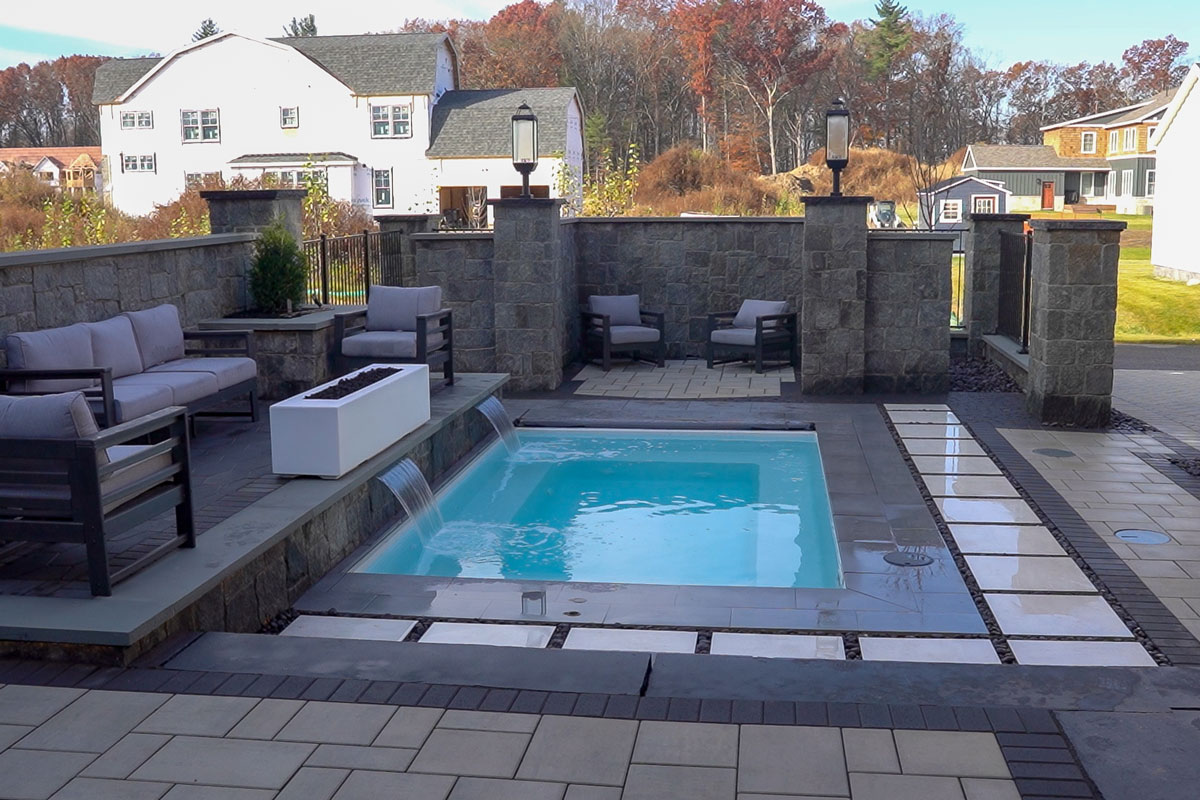
Fiberglass Pool Maintenance in New York
Fiberglass pools are more than just a pretty face! They’re equally beloved for their low-maintenance factor as they are their beauty. That said, fiberglass pools still require a regular maintenance schedule to keep them looking their best, but are less demanding than older pools.
Here is a checklist of fiberglass pool maintenance tasks to help keep your pool in tip-top shape for years to come:
Weekly pool maintenance tasks
- Check water levels and refill as-needed due to evaporation.
- Pro tip: Adding a cover to your pool can help reduce energy costs and water usage by minimizing evaporation.
- Check your water pH, chemistry levels, and balance accordingly.
- Skim your pool a few times each week to fish out any leaves or debris that could throw off your water chemistry or clog filters.
- Empty your filter basket weekly and/or after large gatherings or pool parties
- Scrub and/or vacuum your pool twice per week.
- Pro tip: Look for a soft nylon bristle brush that will gently clean the walls of your pool without scratching or dulling its fiberglass surface.
- Program your filter to run for at least six hours per day during prime pool season.
Monthly / periodic pool maintenance tasks:
- Test your water chemistry. Be sure your pool’s pH and alkalinity are properly balance. Also, test for calcium hardness in your water, making sure your pool’s pH and alkalinity are balanced, as well as testing for calcium hardness. An excess of calcium can form a crusty film on the walls of your pool and equipment, leading to permanent damage.
- Clean your filter regularly.
- Back-flush your filtration pipe.
- Check your pools for cracks and stains. Stains should be removed immediately with a soft bristle brush so that they don’t set and become more difficult to remove later.
Inground Vinyl Liner Pools in New York
New Yorkers also gravitate towards vinyl liner pools as another affordable and attractive option. Whether you’re considering building a new pool or want to give an older pool a makeover, a vinyl liner pool can be a fantastic choice. To help you make the right choice for you and your family, we’ll discuss the finer points of vinyl liner pool ownership – including what to inspect during the installation process, maintenance tips and more.
Vinyl Liner Pool Designs for New York Homes
Tastes change, but pools are timeless! Vinyl liner pools offer versatility and longevity, giving you plenty of room for customization. Typically, a vinyl liner can last approximately 10 years if well-maintained, but if you’re bored with the look of your pool, it can be swapped out as a relatively inexpensive way to refresh its appearance. Vinyl liner pools also pose an affordable solution to renovating older concrete pools, giving you more enjoyment with less upkeep.
Vinyl liner pools come in the same array of shapes and sizes as fiberglass pools, giving you tons of options to choose from in sizes designed to fit any size of backyard. They also lend themselves to a variety of customization options and add-ons, such as tanning ledges or breathtaking features like fountains or LED pool lights.
There’s a pool for every personality! Get to know the various vinyl liner pool shapes and models to whet your appetite for a thrilling new addition to your backyard. Contact a New York Latham dealer in your area to learn more and start planning the pool of your dreams today.
Vinyl Liner Pool Installation Process in New York & NYC
Have your heart set on a beautiful new vinyl liner pool? As with anything worthwhile, it takes a little time and planning to be sure it’s done right and will give you decades of enjoyment. Not to worry, though! A knowledgeable pool builder will be able to help bring the pool of your dreams to life. Here’s what to expect with your vinyl liner pool installation process:
- Your builder will measure the area.
As a critical first step, your pool builder will measure the area for your pool in your backyard. This will take into account any allowances needed for decking surrounding the pool and easements required. - Assessing your backyard and obtaining permits.
Your builder will survey your backyard, checking for buried or overhead utilities, as well as natural features of your yard that may require special handling during the installation process, such as porous soil or uneven terrain. Your builder will also obtain the proper permits to ensure your new pool is compliant with all state and local building codes. - Excavating your backyard.
Once the proper permits are secured, your builder will then bring in equipment to begin to digging a space for your new pool. - Adding steel walls for your pool’s framework.
Once excavation has been completed, your builder will place steel walls that will serve as your pool’s frame. - Pouring concrete.
Once again, you’ll see more machinery in your yard. To secure the newly-installed steel walls, your builder will pour concrete, cementing them in place and creating the “shell” of your pool. - Placing your liner.
Once your pool has been set in place, your builder will add a fresh liner that gives your pool its color and character. Your options are virtually endless – and if you want to (virtually) see what a new liner may look like before committing, check out our vinyl liner visualizer tool to help you customize the look and feel of your pool. - Smoothing out liner wrinkles.
Before the liner is sealed in place, your builder will take care to smooth out any wrinkles. Not only does this give your pool a polished look, but it ensures that the liner is neither too tight or too loose. - Your builder fills your pool with water and seals the liner.
Your pool builder will use a liner vacuum to be sure your liner is free from any air leaks before filling it with water. The weight of the water helps to seal your liner in place. Once your liner has been secured, your builder will trim any excess vinyl, giving your pool a finished appearance.
Replacing Vinyl Liners or Reshaping Your Pool
A pool isn’t just a place where you and your loved ones gather to make memories. It’s a part of your home that can grow and change along with your family and lifestyle. Maybe the kids have flown the nest and you want to transform your pool from a raucous mini waterpark to a relaxing sanctuary. Or maybe you just want to modernize your aesthetic.
While a well-maintained vinyl liner can last for 10 years, you’ll eventually need to replace it due to normal wear and tear. However, replacing your liner can also be a great way to give your pool a facelift, adding a splash of vibrant color or giving it a more tranquil, soothing effect.
Changing the shape or depth of your pool is a bit more complicated than simply swapping out your vinyl liner. However, reshaping your pool can be a great way to better accommodate a lifestyle change and get more mileage from your pool. For example, if you have young children or adults with mobility issues, adding multiple exit and entry points and more shallow areas can make sure everyone enjoys your pool.
Similarly, if your children are grown and you’re ready to enjoy the empty nest phase of life, reshaping your pool can give you an opportunity to make it a fun-filled oasis for time with friends. Adding a spillover spa or tanning ledges to change the shape of your pool can allow it to accompany you into a new era.
Maintaining Your Vinyl Liner Pool
To keep your pool looking its best and allow you to enjoy it for many years to come, here are some vinyl liner pool maintenance tips to keep in mind:
- Regularly check your water chemistry. New York residents experience all four seasons – from hot, humid summers to rainy autumn and spring seasons. And while April showers can bring May flowers, rainfall can throw off the delicate balance of your pool’s water and contribute to algae bloom. Learn how to properly balance your water chemistry with your vinyl liner pool, or ask a professional for tips to help keep your pool in good working condition!
- Don’t allow chemicals to make direct contact with your liner. When balancing your pool water, be sure that the chemicals you use do not make undiluted contact with your liner. Take care to ensure any chemicals such as chlorine or bleach touch only the water of your liner, as they can accelerate deterioration on your vinyl liner.
- Brush your liner weekly with a soft brush. Use a soft-bristle brush or sponge to gently brush your liner once each week. This can prevent dirt, stains and deposits from building up.
- Never empty your vinyl liner pool completely. Winterizing your pool is a must for New Yorkers. Before you close your pool for the season, be sure that you only partially drain your vinyl liner pool. Partial drainage can guard against water freezing and expanding inside your pool, potentially causing damage to your liner and your pool’s shell. If you drain your pool completely, your liner can shrink or tear. As a rule, never drain your vinyl liner pool beyond more than half its total volume. This can help preserve your liner, making it all the easier to dive back in once warmer temperatures return!
- Only use pool-safe toys. Avoid any toys or pool furniture with sharp edges, as they can tear or damage your liner. Stick to foam pool noodles, inflatable floats and other toys made with pool fun in mind!
- Smooth out any wrinkles in your liner. Your vinyl liner can develop wrinkles for a number of reasons, including poor water chemistry or general wear and tear. You can sometimes smooth out these wrinkles by walking along the pool floor and spreading them gently with your feet. In cases where your liner wrinkles are more pronounced, you may want to call in a professional instead of risking damage.
- Check for leaks and tears in your liner. A wrinkly pool liner isn’t just unattractive. It may indicate a leak. Be sure to inspect your pool every so often to check for any signs of leaks. If you spot a small tear, patch it immediately to help prevent it from worsening and from having to replace your liner.
New York Pool FAQs
What type of inground pool is best for New York?
New York is made up of many different cities and towns, each with its own style and flavor. From Rochester to Buffalo to the Five Boroughs, New Yorkers have very particular tastes and strong opinions. In recent years, fiberglass and vinyl liner inground pools have become two of the most popular types of pools among New York residents, thanks to their ease of maintenance and potential for customization.
According to Jon Foshee of Concord Pools & Spas, “Polymer wall, vinyl lined is fully customizable to fit in any space. In a polymer system, your pool deck is supported by the patented I-Brace system. Each I-Brace spaced at 3’ increments around the pool frame will hold 425 pounds of concrete. This is the foundation for your pool deck and eliminates settling and heaving.”
As for fiberglass, he goes on to explain that “modern materials are used to create a family and pet-friendly pool. The non-porous, smooth surface is impervious to damage from sharp objects and comes in magnificent colors that come to life under LED lighting. Fiberglass pools are feature rich and have interior details that are impossible to achieve in any other pool design. Your Latham builder will be able to go over the benefits in greater detail and offer the best pool for your needs.”
If you’re considering making a new pool part of your family, an experienced pool builder can help you narrow down your choices and offer expert advice on choosing a pool that you’ll enjoy for years to come.
What permits are required to put a pool in my backyard in New York?
If you live in New York, it’s important to check with your local building offices to confirm what permits you may need in order to start constructing your pool. Ordinances, requirements and restrictions can vary across towns, cities and municipalities throughout New York State.
For instance, all backyard pools in New York City require a permit, with the exception of:
- In-ground pools less than 400 square feet and that have an existing slop-sink connected to a sanitary sweet for drainage
- Above-ground pools less than 48 inches deep and less than 500 square feet in area
Regardless, all New York City pools must have a permit prior to construction and the city requires that all pool plans be filed by either a licensed architect or engineer. To install a pool in New York City, you’ll need a work permit (obtained from the Department of Buildings), a plumbing permit if your pool connects to the city’s sewer system, an electrical permit (for pumps and filtration), as well as a fence permit. If your property is in a zoning district that requires a permit for swimming pools, you may also need a zoning permit from the Department of City Planning.
Different municipalities may have more restrictive code and zoning requirements, as well as more stringent safety requirements of pool owners depending on where you live in the state. Be sure to do your homework before breaking ground on a new pool.
How much does a pool permit cost in New York
The cost of a pool permit can vary throughout New York state, depending on where you live. For instance, it costs $150 for an above ground pool permit in Freeport, New York and $300 for an in-ground pool permit. Conversely, Utica, NY charges $150 for swimming pools up to $10,000 worth of work. If your pool costs over $10,000, the city charges an additional $7.00 for each additional $1,000 worth of work on your pool. Because costs can vary drastically from town to town, be sure to check with your local building office to confirm what permits are required and associated fees.
It’s important to note that the New York State Uniform Code defines a swimming pool as any recreational structure that is designed to hold water over 24 inches deep. This definition extends to in-ground and above-ground pools, as well as indoor pools, hot tubs, spas and fixed-in-place wading pools. So, be prepared to apply for a permit if you plan to break ground on any structure that New York state considers a pool!
Can I build a pool in my small New York backyard?
Yes! You can absolutely build an inground pool in your small backyard! The truth is, no pool is too small – nor is any backyard too small to benefit from a compact-sized pool that works with your surroundings. Pools come in all shapes and sizes and a skilled builder can help you add a new pool to your small backyard, regardless of size.
Much like the tiny house phenomenon has taken hold, smaller pools have also found favor with homeowners due to backyard sizes and the fact that smaller pools can be quite affordable. Plunge pools, dipping pools, and cocktail pools all offer their own unique benefits. Plunge pools can offer you a place to exercise and relax, while dipping pools and cocktail pools can give you a relaxing oasis ideal for wading or lounging around. Explore your options and you will be pleasantly surprised!
New Yorkers are no strangers to having smaller backyards, but adding a pool can make you the toast of the block and pack a lot of fun into a smaller space and budget.
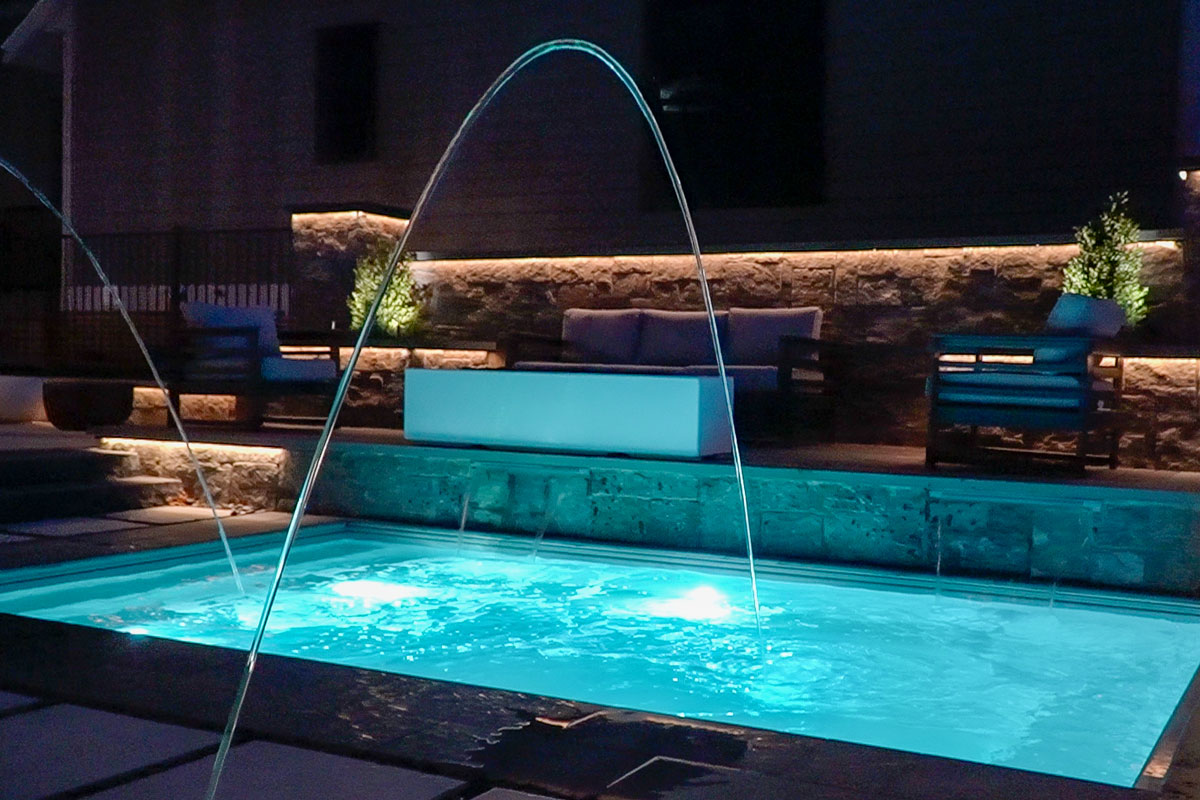
How long will a fiberglass pool last in New York?
The longevity of a well-maintained fiberglass pool in New York can range between 25 to 30 years – or potentially longer. Fiberglass pools offer lots to love, including ease of maintenance. Take good care of your pool and you’ll enjoy it for decades to come!
Latham Pool, Servicing New York & New York City
Since 1956, Latham has helped many homeowners become pool owners throughout New York and New York City. Our roots as a company are in New York and we proudly serve such areas including:
- Latham, NY
- Schenectady, NY
- Albany, NY
- Plattsburgh, NY
- Burlington, NY
- Poughkeepsie, NY
- Torrington, NY
- Long Island, NY
- Yonkers, NY
- NewBurgh, NY
- Buffalo, NY
- Lockport, NY
- Saratoga Springs, NY
- Rochester, NY
- Dunkirk, NY
- Syracuse, NY
- Watertown, NY
- Binghamton, NY
- New York City, NY
Start Building a Pool for Your New York Home Today
“Finding the right pool starts with finding the right builder,” observes Jon Foshee of Concord Pools & Spas. “Do your research and seek out a reputable company. Check references. Bring ideas to the design consultation that best represents your style. Dream big! Even if you’re not planning on adding all the features upfront, you can save a lot by installing the infrastructure for future add-ons. Proper space design is critical, and a reputable pool designer is vital.”
A new pool can give your backyard even more character and help you make countless memories with loved ones. Join the thousands of happy customers who love their Latham pool and speak to an expert builder today to make the pool of your dreams a reality.


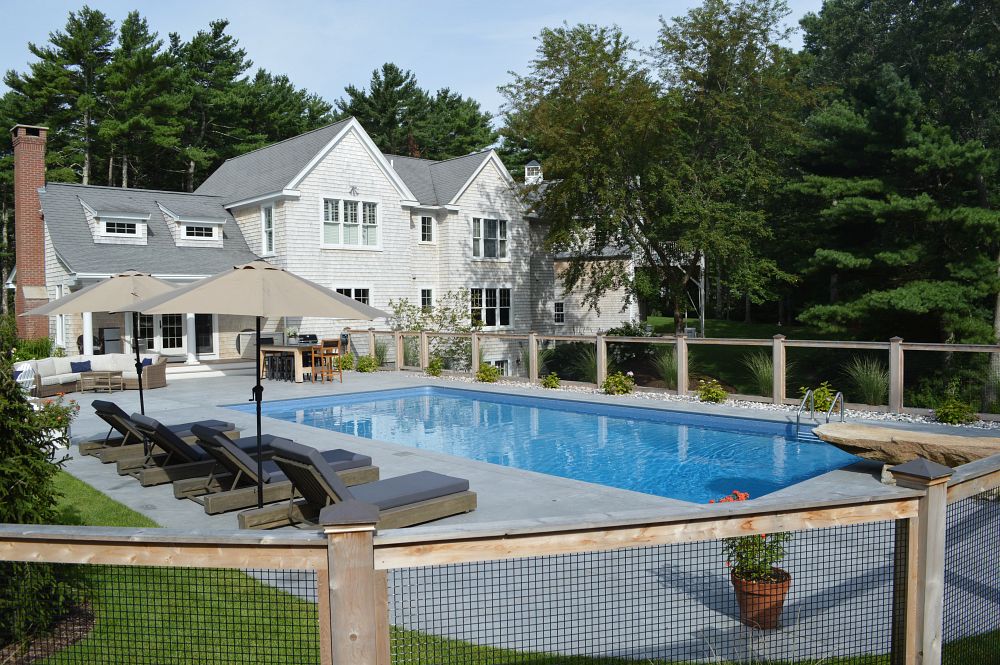
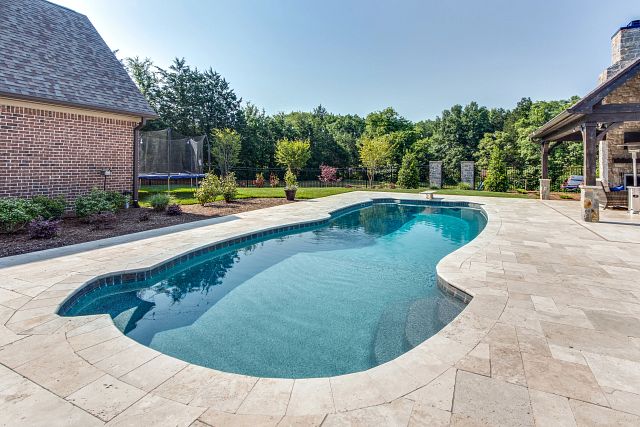
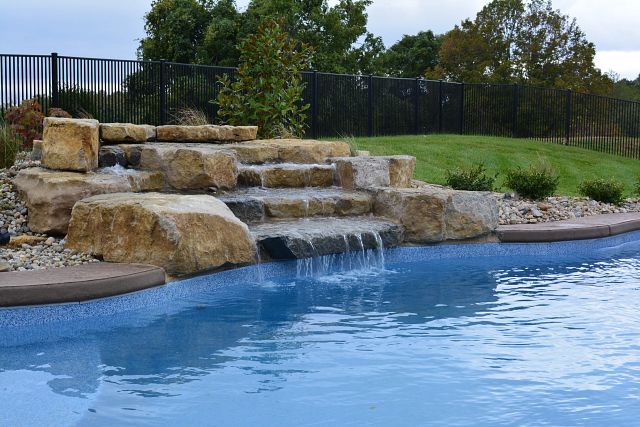
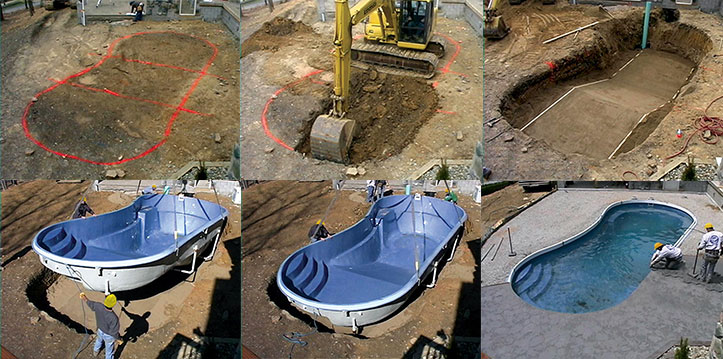
Join the discussion